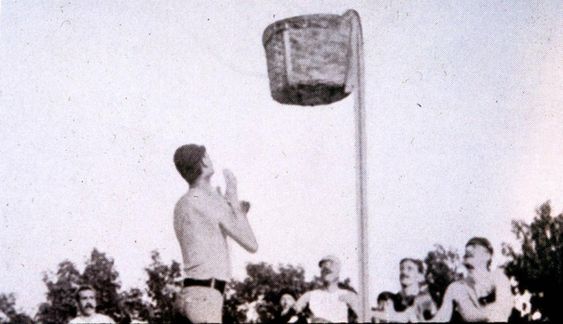
Where was Basketball Invented: A Historical Journey
Basketball is one of the most popular sports worldwide, known for its fast-paced action, strategic depth, and cultural impact. Its origins, however, are rooted in a simple idea born out of necessity. This post explores the Where was Basketball Invented, tracing its invention, evolution, and global expansion.
The Birthplace of Basketball: Springfield, Massachusetts
Basketball was invented in December 1891 by Dr. James Naismith, a Canadian physical education instructor, at the International YMCA Training School in Springfield, Massachusetts, USA. The invention of basketball was a solution to a problem faced by the YMCA. During the harsh New England winters, finding indoor activities to keep students physically active was challenging. Traditional sports like soccer and football were impractical indoors, and other activities failed to engage students effectively. Read about How Long is a Basketball Game
Dr. James Naismith: The Visionary Behind Basketball
Dr. James Naismith was born on November 6, 1861, in Almonte, Ontario, Canada. He attended McGill University in Montreal, where he was a skilled athlete. After graduating with a degree in physical education, Naismith went on to work at the YMCA Training School in Springfield.
Naismith was tasked with creating a new indoor game to keep his students engaged and physically active during the winter months. Drawing on his own experiences and understanding of sports, he set out to develop a game that was both safe and enjoyable indoors.
The Creation of Basketball: A New Game is Born
In December 1891, Naismith devised a game that would eventually become basketball. The initial concept was simple yet innovative. He nailed a peach basket onto the elevated track of the YMCA gymnasium and used a soccer ball as the game’s first ball. The objective was to throw the ball into the opposing team’s peach basket, which was hung 10 feet above the floor.
The first game of basketball was played with nine players on each side and had 13 basic rules, many of which still form the foundation of the sport today. These rules emphasized skill over brute force and prohibited running with the ball, physical contact, and the use of fists to hit the ball.
The Original 13 Rules of Basketball
Dr. Naismith’s original 13 rules provided a framework for basketball’s gameplay and philosophy. Here are some of the key rules:
- The ball may be thrown in any direction with one or both hands.
- The ball may be batted in any direction with one or both hands (never with the fist).
- A player cannot run with the ball; the player must throw it from the spot on which they catch it, allowing for a player running at good speed.
- The ball must be held in or between the hands; the arms or body must not be used for holding it.
- No shouldering, holding, pushing, striking, or tripping in any way of an opponent. The first infringement of this rule by any person shall count as a foul; the second shall disqualify him until the next goal is made or, if there was evident intent to injure the person, for the whole of the game. No substitute.
- A foul is striking at the ball with the fist, violation of Rules 3, 4, and such described in Rule 5.
- If either side makes three consecutive fouls, it shall count as a goal for the opponents (consecutive means without the opponents in the meantime making a foul).
- A goal shall be made when the ball is thrown or batted from the ground into the basket and stays there, providing those defending the goal do not touch or disturb the goal. If the ball rests on the edges and the opponents move the basket, it shall count as a goal.
- When the ball goes out of bounds, it shall be thrown into the field of play and played by the first person touching it. In case of dispute, the umpire shall throw it straight into the field. The thrower-in is allowed five seconds; if they hold it longer, it shall go to the opponent. If any side persists in delaying the game, the umpire shall call a foul on them.
- The umpire shall be the judge of the men and shall note the fouls and notify the referee when three consecutive fouls have been made. The umpire shall have the power to disqualify men according to Rule 5.
- The referee shall be the judge of the ball and shall decide when it is in play, in bounds, and to which side it belongs, and shall keep the time. They shall decide when a goal has been made and keep account of the goals with any other duties that are usually performed by a referee.
- The time shall be two fifteen-minute halves, with five minutes’ rest between.
- The side making the most goals in that time shall be declared the winners. In the case of a draw, the game may, by agreement of the captains, be continued until another goal is made.
These rules emphasized the skill, agility, and cooperation required to excel in basketball.
The First Game of Basketball
The first game of basketball was played on December 21, 1891, in the gymnasium of the YMCA Training School. The game featured two teams of nine players each, and the final score was a modest 1-0. The only point was scored by a student named William R. Chase, who successfully shot the ball into the opponent’s peach basket.
The initial game was a success, and the students enjoyed the new sport. The popularity of basketball quickly spread beyond the YMCA in Springfield, as students introduced the game to other YMCAs, schools, and colleges across the United States.
Evolution and Growth of Basketball
The early years of basketball saw rapid growth and development. In 1893, the first women’s basketball game was played at Smith College in Northampton, Massachusetts. Senda Berenson, a physical education instructor, adapted Naismith’s rules for women, marking the beginning of women’s basketball.
Basketball’s popularity continued to grow, leading to the establishment of formal organizations and competitions. The first professional basketball league, the National Basketball League (NBL), was founded in 1898, although it only lasted six years. The NBL’s creation was a significant milestone, as it paved the way for future professional leagues.
Basketball in the 20th Century
As basketball gained popularity in the United States, it also began to spread internationally. The YMCA played a crucial role in introducing basketball to countries around the world. By the early 1900s, basketball had become a global phenomenon, with organized games being played in Europe, Asia, and Latin America.
The first international basketball competition took place in 1904 at the St. Louis World’s Fair, where teams from different countries competed. This event marked the beginning of basketball as an international sport.
The Formation of Professional Leagues
The 20th century saw the formation of professional basketball leagues in the United States, leading to the development of the sport at the highest level. The National Basketball Association (NBA), founded in 1946, quickly became the premier professional basketball league in the world. The NBA played a pivotal role in elevating basketball’s status and popularity, showcasing the talents of legendary players like Bill Russell, Wilt Chamberlain, and later, Michael Jordan.
In addition to the NBA, other leagues were formed, such as the American Basketball Association (ABA), which existed from 1967 to 1976 before merging with the NBA. The ABA introduced innovations like the three-point line and the slam dunk contest, which became integral parts of the game.
Basketball’s Global Reach
Basketball’s global appeal continued to grow throughout the 20th century. The sport was included in the Olympic Games for the first time in 1936, further cementing its status as a major international sport. The United States dominated the early years of Olympic basketball, but other countries quickly developed competitive teams.
FIBA (Fédération Internationale de Basketball), the international governing body for basketball, was established in 1932 to oversee international competitions and promote the sport globally. FIBA organized the first Basketball World Cup in 1950, showcasing top teams from around the world.
The Rise of Women’s Basketball
Women’s basketball also saw significant growth in the 20th century. The formation of the Women’s National Basketball Association (WNBA) in 1996 provided a professional platform for female athletes, allowing them to showcase their talents and contribute to the sport’s growth.
The WNBA’s success has inspired young female athletes worldwide, leading to increased participation in basketball at all levels. Women’s basketball has become an integral part of the sport’s landscape, with players like Lisa Leslie, Diana Taurasi, and Sue Bird achieving legendary status.
The Cultural Impact of Basketball
Basketball’s influence extends beyond the court, as it has become a significant cultural force. The sport has inspired countless individuals and communities, providing a platform for social change and empowerment. Basketball has produced iconic figures who have transcended the game, becoming global ambassadors and role models.
In the United States, basketball has played a crucial role in advancing civil rights and social justice. Players like Kareem Abdul-Jabbar, Bill Russell, and more recently, LeBron James and Maya Moore, have used their platforms to advocate for equality and social change.
Basketball in Popular Culture
Basketball’s impact on popular culture is evident in various forms of media, including film, music, and fashion. Movies like “Hoosiers,” “Space Jam,” and “Coach Carter” have captured the essence of the sport and its cultural significance. Music artists have often referenced basketball in their songs, further solidifying the sport’s connection to popular culture.
Conclusion:
The invention of basketball marks a pivotal moment in sports history, originating in Springfield, Massachusetts, USA, in 1891. Conceived by Dr. James Naismith as a solution to keep athletes active indoors during the winter, basketball quickly evolved from its humble beginnings into a global phenomenon. Its blend of athleticism, strategy, and teamwork has transcended borders, cultures, and generations, making it one of the most beloved and widely played sports worldwide. From its first game with a soccer ball and two peach baskets to the sleek courts and professional leagues of today, basketball continues to inspire and unite people of all backgrounds, celebrating both competition and camaraderie.
FAQs
Q. Who invented basketball and where?
Basketball was invented by Dr. James Naismith in Springfield, Massachusetts, USA, in 1891.
Q. What were the original rules of basketball?
The original game involved nine players per side and a soccer ball, aiming to throw it into peach baskets nailed to the gym balcony.
Q. When did basketball become an Olympic sport?
Basketball became an Olympic sport in the 1936 Berlin Games, and it has been a staple of the Summer Olympics since then.
Q. Who won the first NBA championship?
The Philadelphia Warriors (now Golden State Warriors) won the first NBA championship in the 1946-1947 season.
Q. How has basketball evolved over time?
Basketball has evolved from its early days with simple equipment and fewer rules to a fast-paced game with standardized rules, professional leagues like the NBA, and global popularity.

Alex Johnson is a vibrant young blogger with a flair for storytelling and a love for sharing his experiences. His blog covers a diverse range of topics, from personal adventures and creative projects to practical advice and thought-provoking insights. Alex’s engaging writing style and unique perspective captivate readers, making his blog a go-to source for fresh and inspiring content. Outside of blogging, Alex enjoys reading, playing sports, and discovering new interests. Follow along with Alex’s journey as he explores the world and shares his discoveries with enthusiasm and creativity.

